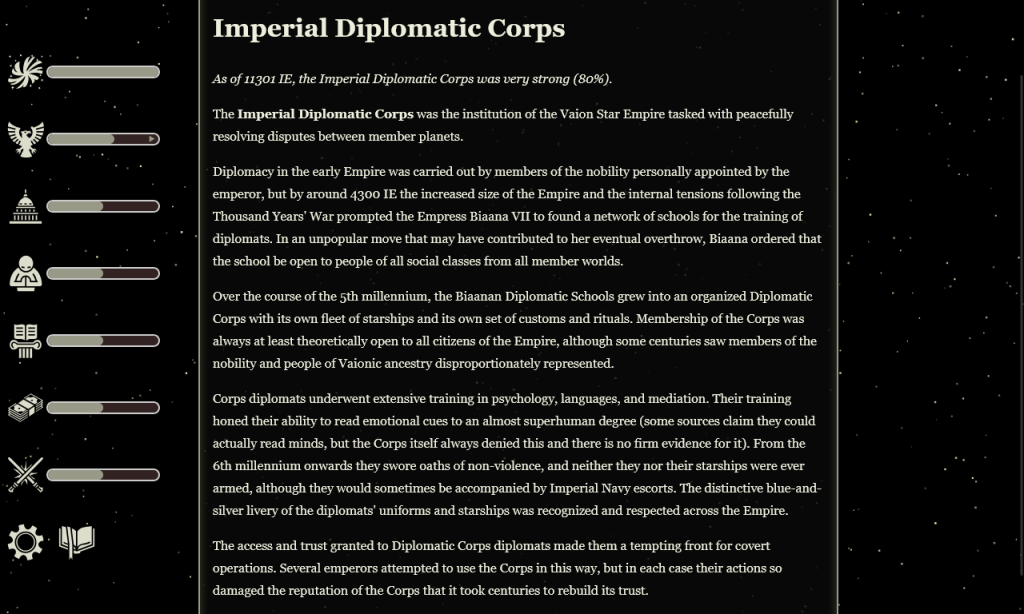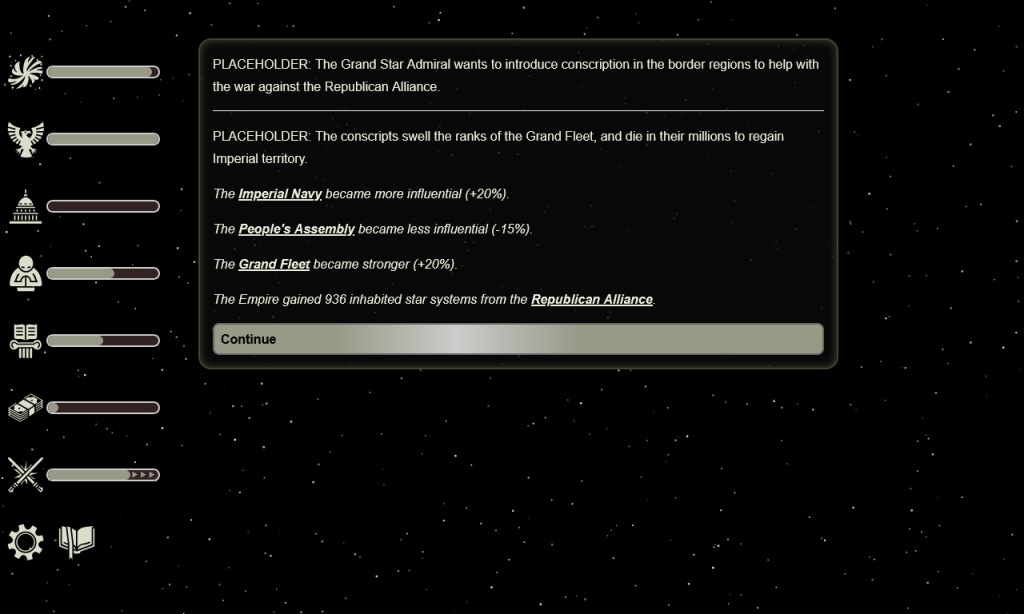
Empire and Legacy continues its progress from a disparate set of random events to a coherent game. This month I’ve been finalizing the stats I’m using to model the Galactic Empire.
Factions
There are seven bars that are always visible on the left side of the game window. The topmost one shows how much of the galaxy the Empire currently controls, and the other six show the how much political influence each of the major factions currently have.

The factions are:
- The High Noble Houses
- The People’s Assembly
- The Galactic Church
- The Academic Council
- The Guild of Extraction companies
- The Imperial Navy
(I’m probably going to change the appearance of the territory bar to distinguish it from the others, but I’m not sure how yet.)
As Emperor, you’ll spend a lot of your time dealing with these factions. The bars can change rapidly, representing the cutthroat vicissitudes of court politics. If you consistently favour or disfavour a particular faction, you can get its bar to the top or bottom pretty quickly. Conventional Imperial wisdom is that keeping the Empire stable relies on not letting that happen, but perhaps it’s what the galaxy needs.
My original idea was to have each of these factions represent both an interest group at court and also a part of the Empire’s infrastructure. I’d do this by either giving each one two bars, for strength and approval rating, or by having the single bar represent both a hybrid of how influential and how powerful the faction was. I’ve realized that both of these approaches are too limiting, so this month I’ve added separate stats for…
Institutions
While factions represent interest groups jockeying for position in the Imperial court, institutions represent the actual machinery with which the Empire rules the galaxy. Each institution has a strength score from 0 to 100. These change less rapidly than the factions’ influence levels, and they will also tend downwards, representing the Empire’s decline. Some events use these scores as success chances in skill checks, e.g. if the Diplomatic Corps has 60% strength then it has a 60% chance of negotiating a peace treaty.
Some of the institutions are associated with a particular factions (e.g. the Grand Fleet and Anti-Piracy Fleet are the two branches of the Imperial Navy) but most of them fall between factions or aren’t associated with a faction at all.
Because the institution scores change less rapidly than the faction scores, I’m not showing them on the main page. Instead, you can see the scores from the Galactopedia index page, which doubles as a stats screen.
![Factions
Academic Council (somewhat influential [50%])
Galactic Church (somewhat influential [50%])
Guild of Extraction Companies (somewhat influential [50%])
High Noble Houses (influential [60%])
Imperial Navy (somewhat influential [50%])
People's Assembly (somewhat influential [50%])
Institutions
Chalandrian Knights (weak [40%])
Ectogenetic Sisterhood (strong [60%])
Grand Fleet (strong [60%])
Imperial Archaeological Society (strong [60%])
Imperial Development Network (strong [60%])
Imperial Diplomatic Corps (very strong [80%])
Imperial Hyperspace Beacon Network (very strong [80%])
Imperial Palace (weak [40%])
Imperial University Network (strong [60%])
Naval Anti-Piracy Command (strong [60%])
Order of the Mirrored Blade (very strong [80%])
Order of Worldshapers (very strong [80%])
Zarvonian Benevolent Order (strong [60%])](https://johnayliff.com/blog/wp-content/uploads/2024/09/Screen-Shot-2024-09-27-at-16.37.51-1024x614.png)
I haven’t decided on the final list of institutions yet (I’ll almost certainly cut some of the ones in the above screenshot), but some of the ones I’ve settled on are:
- The Grand Fleet
- The Anti-Piracy Fleet
- The Diplomatic Corps
- The Imperial Development Network
- The Hyperspace Beacon Network
- The Order of the Mirrored Blade (your spies and assassins)
- The Imperial Palace (the score represents how grand and well-maintained the palace is)
Because the Empire is so ancient, many of these institutions are thousands of years old and have their own traditions and rituals. (Here I’m taking inspiration from Dune, in which every character seems to be a representative of a different quasi-religious organization with its own traditions, symbols, and particular strain of drug-aided mental conditioning.)
If you’re the kind of person who likes reading encyclopedia articles about fictional worlds, you can read about each institution’s history and practices:

If you’re not the kind of person who likes reading encyclopedia articles about fictional worlds, that’s fine too. I’m trying to write the game such that the Galactopedia articles are interesting if you want to read them, but you never feel like you have to read them if you don’t want to. Anything you really need to know will be in the main game text.
As the Empire gradually loses systems, a third kind of game entity will come into play…
Nations
![Galactopedia
Index
Galactopedia is under construction. It is currently complete as of 11315 IE (15th year of the reign of Ulleion XLVIII).
Nations
Republican Alliance (3035 systems)
Unaligned Systems (1603 systems)
Vaion Star Empire (5362 systems)
Factions
Academic Council (very influential [85%])
Galactic Church (influential [75%])
Guild of Extraction Companies (not at all influential [20%])
High Noble Houses (influential [70%])
Imperial Navy (influential [60%])
People's Assembly (not at all influential [0%])](https://johnayliff.com/blog/wp-content/uploads/2024/09/Screen-Shot-2024-09-27-at-16.43.27-1024x614.png)
When a faction gets so unhappy that it can no longer support you, it spawns a corresponding nation, and you can either go to war with it let it secede in peace. Each nation has a stat for how many systems it currently controls, and a flag for whether it’s at war with the Empire or not. (The nation is a separate entity from the faction that spawned it, which now represents that part of the faction that’s still inside the Empire.)
Being at war adds a bunch of events (currently all with placeholder text) that let you gain or lose systems while also affecting the influence levels of factions or the strength of institutions. The number of systems you gain/lose is often based on the influence level of a faction or the strength of an institution. In this one, deciding to introduce conscription increases the strength of the Grand Fleet, makes the Navy more influential and the People’s Assembly less so, and then the Empire reconquers a number of systems based on the Grand Fleet’s (newly modified) strength.

The number of systems always refers to the number of inhabited systems. In real life there are 100-400 billion stars in the galaxy, but to keep the numbers readable I’ve decided that in the E&L universe only 10,000 of these stars have habitable planets, and those are the only ones that the Empire counts.
Also, I’m using the word “nation” in my code, but the people of the Empire don’t necessarily think of these as “real” nations–they’re unlawful rebellions that temporarily control systems that are still really part of the Empire.
Current plans
Right now I’m focusing on getting the faction takeover/rebellion mechanics working for the first two factions, the Noble Houses and the People’s Assembly. By the end of next month I hope to have a playable game (but unbalanced and with placeholder text) implemented for those two factions, so that I’ll be able to test siding with the nobility and fighting off a democratic rebellion, or bringing about a Galactic Republic and fighting off a monarchist rebellion, or try to side with both or neither. Once I’ve got that working, I’ll extend it to the other four factions (for a ton of possible combinations of embraced/rebelling factions), and then work on adding even more events and filling in all the placeholder text.
The Imperial Discord Server
Also, at the request of a few people there, I’ve added a new channel to the Beyond the Chiron Gate Discord server for the discussion of Empire and Legacy. If you want to say something about it and find Discord more convenient than commenting on this blog, you can head over there.
